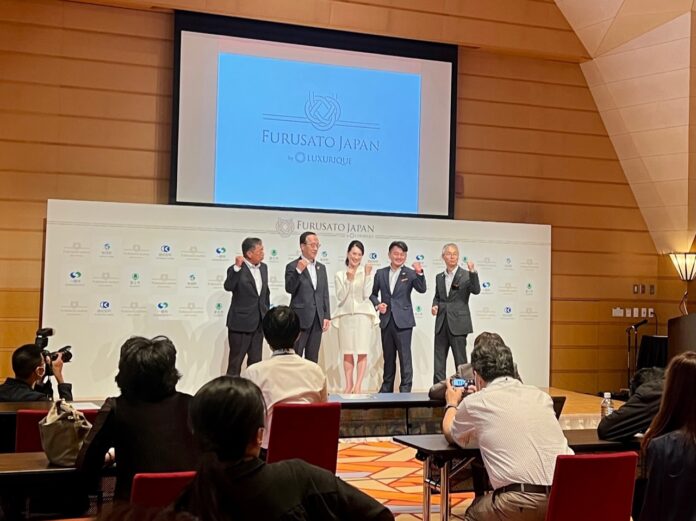Furusato nozei (a hometown tax-deductible donation system that started in 2008), is often used by Japanese taxpayers. In return for paying their income or residential tax to their home towns, they can receive gifts, mainly local specialities, from municipal beneficiaries. It is also deductible from one’s annual tax bill, so both sides benefit from contributions. I personally make use of it every year, and in return, receive wagyu beef, freshly caught fish, and seasonal fruits.
Tax-paying foreign residents are also eligible for this system, but many are not aware of that, and even if they are, they face a hurdle because the web site sections dealing with prefectures’ furusato nozei are only in Japanese.
Luxurique launches Furusato Nozei at a news conference at the Tokyo American Club on September 28. Photo: Mai Shoji
On Oct 1, Luxurique, a start-up based in Tokyo, launched Furusato Japan, a multilingual online platform for furusato nozei. President and CEO, Naomi Mano, says, “Rather than goods or food, I hear that expats would like to invest in tailor-made experiences.”
The company is working with local governments, including Arita City in Saga Prefecture, Fuji City in Shizuoka Prefecture, Ichinoseki City in Iwate Prefecture, and Kutchan town in Hokkaido. Their local governments are in unison to design tax returns that are koto (things) rather than mono (goods).
Furusato Japan aims to promote sustainable domestic tourism by rediscovering Japan’s attractions, and revitalizing local tourism and economies. For example, a two-day package tour to Arita in Saga Prefecture (¥1,750,000 donation) focuses on learning about milky white Aritayaki porcelain, taking you on a journey of 400 years of history.
Arita Mayor Yoshiaki Matsuoi says he is very proud of Arita’s cultural heritage. Photo: Mai Shoji
Arita Mayor Yoshiaki Matsuo says, “We are very proud of our cultural heritage and wish to promote our ‘edgy’ culture to the world.” He explains that in the small town with a population of 20,000, students eat school lunch served in Aritayaki, and that every household own Aritayaki tableware. Considering Aritayaki is known to be a luxury item, owning one in an average household elsewhere is rare, but at the same time you can imagine the weight of the residents’ pride.
A visit to the Ri Sanpei Pottery Studio gives you a better understanding of the history of Aritayaki Kakiemon, a human national treasure. The tour offers special experiences not open to the public, like spinning the potter’s wheel, taught by the 14th generation direct descendant of Ri Sanpei, the original founder of the first Arita stone in Japan. Ri brought the craftsmanship to Arita from Korea and produced porcelain designs as well being the inspiration of the world-renowned Meissen.
Izumiyama Quarry is a power spot. Photo: Mai Shoji
The trip also includes an exclusive tour to the Izumiyama Quarry which is designated as a historic site. The aura that the whitish mountain emits makes you believe it is a so-called power spot. A visit to the Arita Sueyama Jinja shrine makes it even more clear how much people of Arita treasure their own heritage. The steep stairs before the entrance leads to a torii gate and koma-inu, or lion-dogs, made of Aritayaki. The contrast of porcelain and old wood makes it one of the most unique shrines in the world.
Aritayaki, the origin of porcelain in the world, is displayed in the Kyushu Ceramic Museum. Photo: Mai Shoji
At Kyushu Ceramic Museum, guests can enjoy a precious moment with a cup of coffee in an old Imariyaki (an offshoot of Aritayaki) tangible culture asset made in 1780. Needless to say, the staff at the cafe are always incredibly careful not to drop a cup by mistake.
Shinichi Terauchi, president of Aritacera Design Office and 3D Art Studio and Workshop Photo: Mai Shoji
Moving along, Aritacera Design Office and 3D Art Studio and Workshop shows visitors its modern approach and the future of Aritayaki. President Shinichi Terauchi is a friendly soul who has discovered an innovative approach. His artworks are used at restaurant Kaji, in which lunch here is also included in the tour.
Fresh wood blocks used for roasting dishes are piled up at the entrance of Kaji synergy restaurant. Photo: Mai Shoji
Kaji is a modern restaurant surrounded by the forest of Mt Mifune. Panoramic floor to ceiling windows on three sides change scenery according to the season – pink cherry blossoms in April, purple wisteria in May, fresh green leaves in August and a blanket of white snow in January.
Wakasugi pork and local vegetables are roasted with the hardwood from Mt Mifune. Photo: Mai Shoji
Saga beef, Wakasugi pork and Takeo boar, are roasted with hardwood which are methodically piled up in the entrance. Chef, sommelier and owner, Daisuke Kajiwara cooks a theatrical “balance with nature” with local produce on original Aritayaki plates.
The trip includes chartered taxi and an English-speaking guide, with accommodation at Villa Kaede or Arita House. The taxi driver will guide you through the well-preserved street that houses hundreds of buildings which are all registered as a tangible cultural heritage, and a 2,000-year-old tree. It is an eye- opening journey filled with new discoveries. The trip is not only highly recommended for foreign visitors but also for Japanese people as a chance to rediscover their roots and the charms of regional Japan.
Other catered tours that Furusato Japan promotes include Fuji City in Shizuoka Prefecture (for a ¥1,150,000 tax donation), where visitors can enjoy a fishing boat ride and tea ceremony at a tea farm at the foot of Mount Fuji. Ichinoseki City, Iwate Prefecture (¥300,000 tax donation) provides rafting along a river at Geibikei Gorge, listed as one of the 100 most scenic spots in Japan. Professional snowboarding in Kutchan Town, Hokkaido (¥750,000 tax donation) comes with an exclusive access to slopes with powder snow that have not yet been developed for general skiing, with a bonus of photos and videos taken by a professional photographer.
With the tourism cap having been lifted, Japan is anticipating a tide of independent visitors. One hope for the Furusato Japan project is that municipalities will gain from tourists spending money in their cities, towns or villages.
“When these people go back to their countries, they become ambassadors for Japan. That makes them a key demographic,” says Mano, adding that inbound tourism can give Japan an economic boost.
Japan needs to acknowledge that exceptionally great hospitality is its utmost resource, and that needs to be appealed to the world in order for them to return again and again.
- External Link
-
https://furusato-japan.com/
© Japan Today










